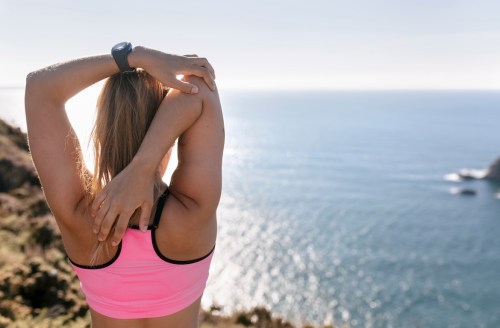This 5-Point Checklist Is Your Key to Better Mobility
Do these five workouts for mobility from Nike Master Trainer Ash Wilking to increase your range of motion and improve joint mobility.

Have you ever tried to squat low, hold a plank, or run a new PR only to feel like your body is simply not able to move the way you want to? Believe it or not, mobility (as in the ability to move through your full range of motion freely) may actually be to blame—not flexibility—which is why performing workouts for mobility is so important.
Experts in This Article
certified personal trainer and Tonal strength coach
After all, the capacity to do all the the above (as well as just flow through your day to day life with ease) comes down to being strong enough to support and stabilize your body in whatever activity its engaged in, according to Nike Master Trainer and Rumble instructor Ash Wilking: “It’s not about being flexible, it’s about finding strength in your mobility.”
With that in mind, she teamed up with Well+Good to share her favorite five workouts for mobility. No matter what form of exercise you prefer—whether it’s running, lifting weights, boxing, high-intensity interval training, barre, Pilates, etc.—Wilking says that mobility can play a major role. So, what are you waiting for? Keep reading for her top movements to ensure your neck, shoulders, wrists, hips, and ankles are able to move in whatever direction you choose.
And watch Wilking demo this 10-minute, full-body mobility workout below:
Neck
In order to increase your neck’s mobility, Wilking recommends neck circles, but in a slow, controlled manner. She says to pull your chin down toward your chest and imagine that you’re squeezing a tennis ball between the two, all without moving the rest of your body. From there, look to your right shoulder, then lift your head and imagine you’re drawing a rainbow up and over toward your left shoulder and then back down to your chest. Switch directions. Repeat this three times and bring your chin up to look forward when you’re finished.
Shoulders
Moving down to your shoulders, Wilking recommends segmented shoulder circles and overhead bent arm raises. Together, these movements target your shoulder, as well as all the muscles surrounding it the help to stabilize it, so you may feel tension in your scapula and clavicle (otherwise known as your shoulder blades and collarbone). Since these movements are a bit more involved, be sure to watch Wilking’s full tutorial within the video above.
Wrists
While wrist mobility may not seem super important, Wilking says that it plays a major role in how well you’re able to do pushups and hold a plank. As a result, she suggests wrist flips to help increase your full range of motion.
To perform the movement, Wilking says to bring your arms to touch your sides, then raise your forearms in front of you so that they’re parallel to the floor and your elbows form right angle with your palms facing up.
“Make strong high-five hands,” she says. With fingers spread wide, flex your your wrists so that your fingers point down toward the floor (palms facing away from you). Then slowly rotate your wrists like you’re waving, so that your fingers point toward the ceiling. Now flip your wrists so that your fingers point back toward the floor, but this time, your palms face your body. Finally, rotate your hands inward so that your fingers point back upward, but this time your palms face you and your pinkies are side by side. Repeat for a few minutes to fully loosen up your wrists.
Hips
Hip kickbacks and hip circles are the trick to better mobility through your pelvic area, according to Wilking. By focusing on this joint (the biggest in your body), you’ll be able to ultimately run faster and squat lower. But, like the shoulders, these hip mobility movements are more involved, so it’s best to watch Wilking’s step-by-step process in the video above to ensure you can execute each properly and with ease.
Ankles
Ankles mobility is paramount for runners, folks who enjoy HIIT workouts, and athletes in general. To ensure your ankles can articulate through the greatest range of motion possible, Wilking says to stand on one foot with your other leg extended forward, foot flexed and a few inches off of the floor. Then point your toes down toward the floor and flex them back up toward your face a few times. Rotate your toes to the right and repeat. Then rotate them toward the left and repeat again.
From there, perform a foot circle by rotating your toes toward the left side, pointing them down toward the floor, then rotating them around toward the right side, and finally straight back up. “Try your hardest not to let your femur move in the process—just your ankle,” Wilking says, noting that doing so will help ensure your ankle is getting the most mobility benefits possible. Once you finish one foot, don’t forget to switch sides.
Oh hi! You look like someone who loves free workouts, discounts for cult-fave wellness brands, and exclusive Well+Good content. Sign up for Well+, our online community of wellness insiders, and unlock your rewards instantly.
Sign Up for Our Daily Newsletter
Get all the latest in wellness, trends, food, fitness, beauty, and more delivered right to your inbox.
Got it, you've been added to our email list.










